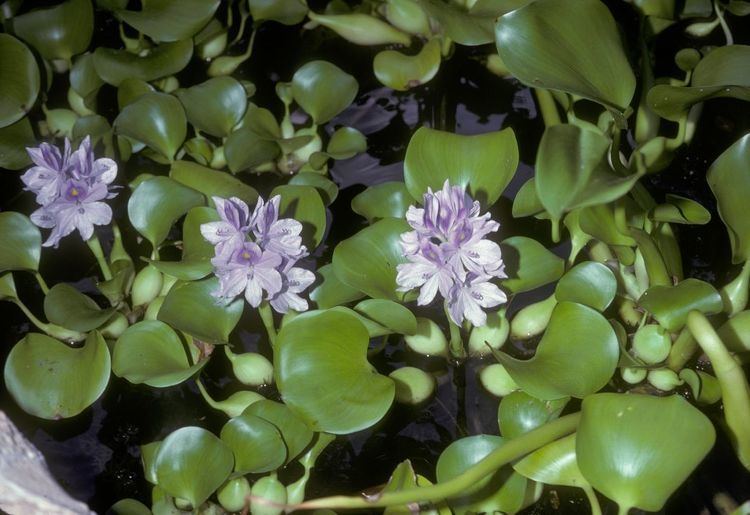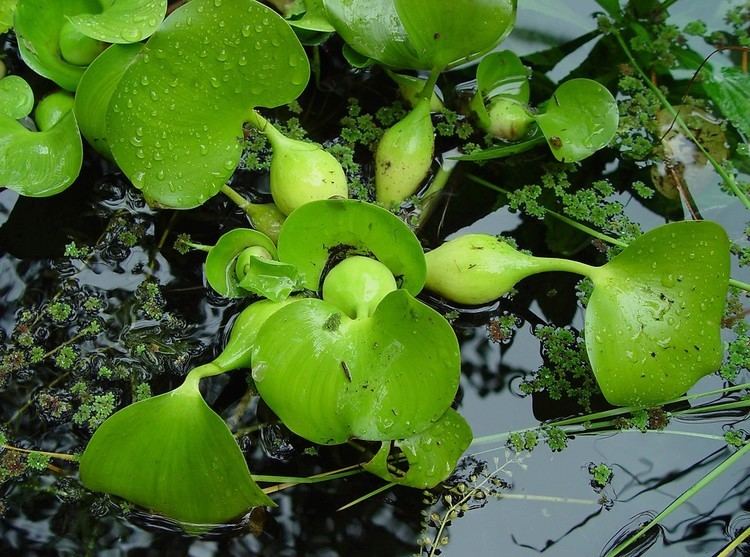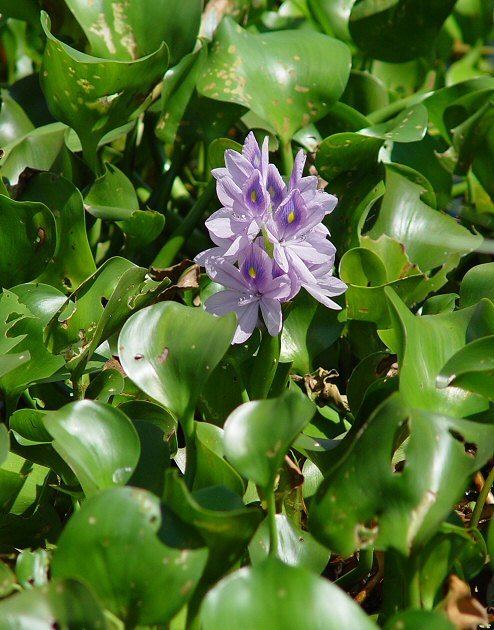Kingdom Plantae Family Pontederiaceae Higher classification Pontederiaceae | Order Commelinales Scientific name Eichhornia Rank Genus | |
 | ||
Similar Common water hya, Pontederiaceae, Pistia, Salvinia, Hyacinth | ||
Water hyacinth eichhornia crassipes
Eichhornia, water hyacinth, is a genus of aquatic flowering plants in the family Pontederiaceae. The genus is native to South America. E. crassipes has become widely naturalized in tropical and subtropical regions and is a significant invasive species.
Contents
- Water hyacinth eichhornia crassipes
- Dennerle eichhornia diversifolia in vitro plant it aqua essentials
- Description
- Invasiveness as an exotic plant
- Uses
- References

Dennerle eichhornia diversifolia in vitro plant it aqua essentials
Description

Eichhornia species are perennial aquatic plants (or hydrophytes) native to tropical and sub-tropical South America, excepting E. natans from Africa. An erect stalk supports a single spike of up to 30 conspicuously attractive flowers, mostly lavender to pink in colour with six petals. When not in bloom, water hyacinth may be mistaken for frog's-bit (Limnobium spongia). The common water hyacinth (Eichhornia crassipes) are vigorous growers known to double their population in two weeks.
Invasiveness as an exotic plant

Water hyacinth has been widely introduced in North America, Asia, Australia, Africa and New Zealand. They can be found in large water areas such as Louisiana, or in the Kerala Backwaters in India. In many areas it, particularly E. crassipes, is an important and pernicious invasive species. First introduced to North America in 1884, an estimated 50 kilograms per square metre of hyacinth once choked Florida's waterways, although the problem there has since been mitigated. When not controlled, water hyacinth will cover lakes and ponds entirely; this dramatically impacts water flow, blocks sunlight from reaching native aquatic plants, and starves the water of oxygen, often killing fish (or turtles). The plants also create a prime habitat for mosquitos, the classic vectors of disease, and a species of snail known to host a parasitic flatworm which causes schistosomiasis (snail fever). Directly blamed for starving subsistence farmers in Papua New Guinea, water hyacinth remains a major problem where effective control programs are not in place. Water hyacinth is often problematic in man-made ponds if uncontrolled, but can also provide a food source for gold fish, keep water clean and help to provide oxygen to man-made ponds.
Water hyacinth often invades bodies of water that have been impacted by human activities. For example, the plants can unbalance natural lifecycles in artificial reservoirs or in eutrophied lakes that receive large amounts of nutrients.
Eichhornia crassipes, the common water hyacinth, has become an invasive plant species on Lake Victoria in Africa after it was introduced into the area in the 1980s.
Uses
Since the water hyacinths are so prolific, harvesting them for industrial use serves also as a means of environmental control.
In north-east India, the Philippines, Thailand and Vietnam the water hyacinth's stems are used as a braiding material and a source of fibers. Strings of dried fibers are woven or interlinked together to form a braid or cord used for making bags, footwear, wreaths, hats, vases, Christmas lanterns, and more decorative materials. Dried stems are used for baskets and furniture. Water hyacinth fibers are used as a raw material for paper.
Since the plant has abundant nitrogen content, it can be used as a substrate for biogas production and the sludge obtained from the biogas. However, due to easy accumulation of toxins, the plant is prone to get contaminated when used as feed.
The plant is extremely tolerant of, and has a high capacity for, the uptake of heavy metals, including cadmium, chromium, cobalt, nickel, lead and mercury, which could make it suitable for the biocleaning of industrial wastewater , , ,. In addition to heavy metals, Eichhornia crassipes can also remove other toxins, such as cyanide, which is environmentally beneficial in areas that have endured gold mining operations.
Water hyacinth removes arsenic from arsenic contaminated drinking water. It may be a useful tool in removing arsenic from tube well water in Bangladesh.
Water hyacinth is also observed to enhance nitrification in waste water treatment cells of living technology. Their root zones are superb micro-sites for bacterial communities.
Water hyacinth is a common fodder plant in the third world especially Africa though excessive use can be toxic. It is high in protein (nitrogen) and trace minerals and the goat feces are a good source of fertilizer as well.
